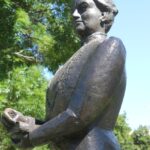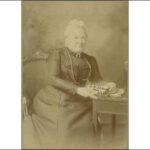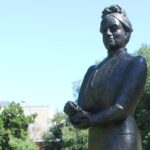Catherine Helen Spence (1825-1910) migrated from Scotland with her family in 1839. In spite of the strictures placed on women during her lifetime, she won recognition as a writer and journalist, social reformer, political activist and preacher.
Public works
Between 1854 and 1889 Spence produced seven novellas and a religious allegory. Her first work Clara Morrison: A tale of South Australia was the first novel about Australia written by a woman. From 1878 she wrote for the South Australian Register newspaper.
Spence was particularly concerned about the education and welfare of children. In 1872 she and Caroline Emily Clark established and ran the Boarding-Out Society for orphaned, destitute and reformed delinquent children committed to the Industrial School. In 1880 she wrote the first South Australian social studies textbook for schools. Spence participated in the work of the State Children’s Council and became a member of the East Torrens School Board.
Spence developed her public speaking skills as a Unitarian preacher. These skills were put to good effect in her campaigning for social and political reform. She became a public figure, addressing public meetings and rallies on electoral reform and legislative change. Spence argued for property rights for women, fairer marriage and divorce laws and for women’s suffrage. She was the first woman to seek political office in Australia; standing unsuccessfully as a delegate to the 1897 Federal Convention. She actively supported proportional parliamentary representation and proposed a Hare-Spence electoral system on the lines of the Hare-Clark system that operates in Tasmania.
The sculpture
The life-size bronze statue of Catherine Helen Spence was unveiled by Queen Elizabeth II on 10 March 1986 as part of the commemoration of 150 years of European settlement of South Australia. It was funded jointly by government and public subscriptions.
The work was commissioned by the Women’s Executive Committee of the South Australian Jubilee 150 Board. The committee sought not only to commemorate Spence’s life, but also to begin to redress Adelaide’s lack of public memorials to women and of the work of female artists in public art. A panel interviewed seven sculptors and selected the design proposed by Ieva Pocius. Pocius was born in Lithuania in 1923 and arrived in Australia in 1951. She studied sculpture at the South Australian School of Art.
Pocius’ portrayal of Spence captures her dignity, strength of character and love of books and learning. She stands composed, in plain Victorian dress. Her left hand holds a book that she is about to open. The three-tiered triangular pedestal supporting the statue is made of polished granite.
The inscription highlights Catherine Helen Spence as a social and political reformer, writer and preacher.







Comments